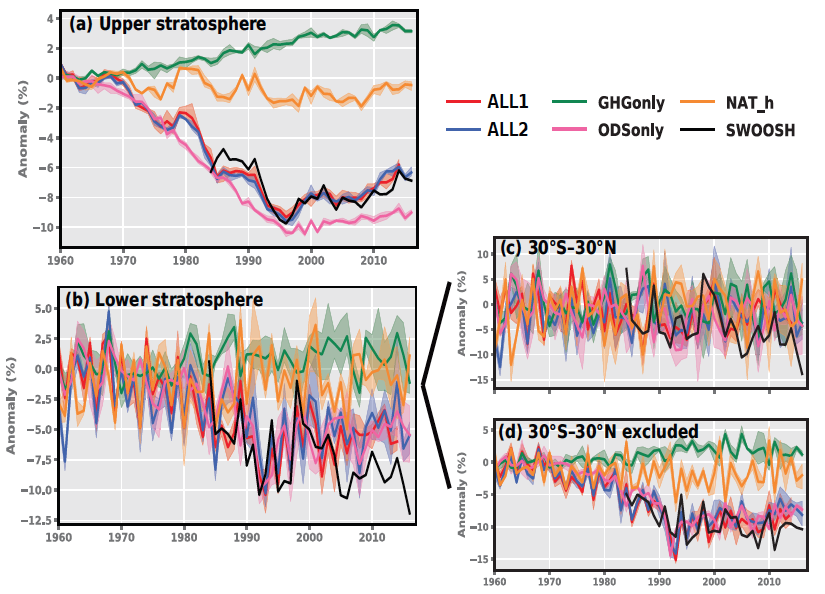Aura Microwave Limb Sounder (MLS) Global O3 profiles are used to detect fingerprints of ODS & GHG impacts. Both changes can affect the O3 depletion and recovery phases.
Global O3 profiles from 1984-2016, based mainly on NASA satellite data (SAGE, HALOE, and MLS monthly means), merged into a homogeneous record ("SWOOSH" ) were used in conjunction with simulations from the "WACCM" model (for attribution studies). Fingerprints of ODS+GHG and ODS-only patterns are detectable in the O3 record (upper and lower stratosphere). While the GHG-only fingerprint is not yet identifiable, it may be detectable in the next 5 to 10 years. Continuing high quality global O3 profiles will be crucial for this detection.

The long-term record of global spaceborne ozone observations from the "SWOOSH" dataset (black, including data from Aura MLS) are compared to model simulations (colors) in broad upper and lower stratospheric averages. The model "Nat_h" is an estimate of natural variability (aerosol, solar, and QBO effects alone, no GHGs/ODSs). Note that the changes in both GHGs and ODSs are needed to explain upper stratospheric O3 increases post-2000. Details of the potential detectability of the GHG-only impacts are described in the paper.
Technical Description of Figure: Figure 1 of above reference. Time series of global mean annual ozone anomalies for (a) the upper stratosphere (1—10 hPa) and (b) the lower stratosphere (40—100 hPa). The right panels show the lower stratosphere for (c) the tropics (30° S to 30° N) and (d) tropics excluded. Annual anomalies were calculated from monthly-mean model output and the "SWOOSH" ozone data set, and both were weighted by latitude and pressure. All WACCM model anomalies are shown as percent differences from the base years of 1960 to 1969 in ALL1. ALL1 is a coupled chemistry and dynamics run with prescribed sea surface temperatures and varying ODS and GHG concentrations. ALL2 is similar, but with an interactive fully coupled ocean component. The "Nat_h" natural variability component was estimated by differencing model runs with different forcings. For model simulations, the spread shows the upper and lower bounds of all ensemble members. The "SWOOSH" record spans the period from 1984 to 2016 and the anomalies were also defined as % differences from the base years of 1960 to 1969 in the ALL1 simulation.
Scientific significance, societal relevance, and relationships to future missions: Society can be impacted globally by man-made forcings (e.g., by ODSs and GHGs). It is critical to identify such forcing patterns, be they changes in temperatures, sea levels, ice sheets, or ozone abundances. The authors note that a signature of the impact of GHGs on ozone profile variations and trends is likely to be detectable within 5-10 years. They also point out that a continuing high quality ozone profile record is necessary for a detection and attribution study to be successful. While current instruments, such as the Aura MLS or Ozone Mapping Profiler (OMPS), are continuing their global ozone profile measurements for now, it is conceivable that critical data gaps might occur in the future.
Data Sources:
The main data sets making up the merged data record from "SWOOSH" (Stratospheric Water and Ozone Homogenized) database are:
Stratospheric Aerosol and Gas Experiment (SAGE II, SAGE III) data, for periods included within 1984-2005.
Halogen Occultation Experiment (HALOE) data, for 1991-2005.
Upper Atmosphere Research Satellite (UARS) Microwave Limb Sounder (MLS) data, for 1991-1999.
Aura Microwave Limb Sounder (MLS) data, from 2004 to current.
More information about "SWOOSH" data and data access
The model simulations from WACCM can be requested
Refereces: Bandoro, J., S. Solomon, B. D. Santer, D. E. Kinnison, and M. J. Mills, Detectability of the impacts of ozone-depleting substances and greenhouse gases upon stratospheric ozone accounting for nonlinearities in historical forcings, Atmos. Chem. Phys., 18, 143-166, https://doi.org/10.5194/acp-18-143-2018, 2018.
4.23.2018